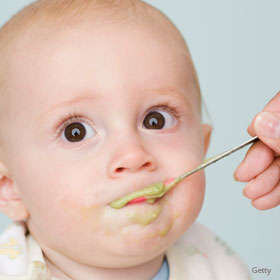Another Veggie Study. Will it Change How You Feed?
 Good reminder: often and early exposures help children learn to like veggies says an article about a recent study, which confirms earlier findings— most children learn to like foods with repeated exposures, and most parents give up after only a handful of tries. (Reminds me of my favorite "green bean study" which states that parents aren't always good at knowing what foods a child "likes," and to keep offering that food.)This study (original here) seems to contradict earlier studies that suggested that a small amount of sugar, or flavors may improve acceptance of veggies and bitter tastes.There was also little difference in the amounts eaten over time between those who were fed basic puree and those who ate the sweetened puree, which suggests that making vegetables sweeter does not make a significant difference to the amount children eat.I have often seen flavor improve variety. I'm thinking of a nine-month old client who refused most veggies and "never seemed hungry," who ate three roasted potato wedges when she was allowed to have the ones the parents were eating that were lightly seasoned with a sprinkle of salt, fresh herbs and garlic. (Mom emailed me ecstatic, wondering what to do with all her home-made purees of plain leeks and potatoes.) It's complicated you see. Were the potatoes eaten because the child was able to palm the mashed food and feed herself? Was it the flavor? Sitting with her parents and eating the same foods rather then being 'fed' separately? The mom's sense of relief and reassurance after our home visit which led to a more relaxed atmosphere? The new schedule that allowed for an appetite instead of the frequent feedings?And then there is this:Most children (40%) were “learners” who increased intake over time. Of the group, 21% consumed more than 75% of what was offered each time and they were called “plate-clearers”. Those who ate less than 10g even by the fifth helping were classified as “non-eaters”, amounting to 16% of the cohort, and the remainder were classified as “others” (23%) since their pattern of intake varied over time.It may be helpful for parents to understand that children come with different approaches and towards new foods...The present investigation demonstrated that children respond differently to an intervention aimed at enhancing vegetable intake....and that appetites vary— often from birth. But, the labels rub me the wrong way. What does a label of "plate-clearer" vs. "non-eater" imply? Is it good or bad to be a plate-clearer? Is the implication that they eat more than they need or are at risk of 'overeating' and need more control? Will a parent of a "plate-clearer" worry and try to limit the child's intake? Is the child a "plate-clearer" partly because they have already been restricted? Similarly, "non-eater?" How will that not worry a parent? Worry and poor support often combine and the parent may find himself in a counterproductive feeding cycle. My guess is that many 'plate-clearers' as well as 'non-eaters' are happy and healthy. (Would terms like "early accepters" or "enthusiastic accepters" or "cautious" be better? What terms might you use?)
Good reminder: often and early exposures help children learn to like veggies says an article about a recent study, which confirms earlier findings— most children learn to like foods with repeated exposures, and most parents give up after only a handful of tries. (Reminds me of my favorite "green bean study" which states that parents aren't always good at knowing what foods a child "likes," and to keep offering that food.)This study (original here) seems to contradict earlier studies that suggested that a small amount of sugar, or flavors may improve acceptance of veggies and bitter tastes.There was also little difference in the amounts eaten over time between those who were fed basic puree and those who ate the sweetened puree, which suggests that making vegetables sweeter does not make a significant difference to the amount children eat.I have often seen flavor improve variety. I'm thinking of a nine-month old client who refused most veggies and "never seemed hungry," who ate three roasted potato wedges when she was allowed to have the ones the parents were eating that were lightly seasoned with a sprinkle of salt, fresh herbs and garlic. (Mom emailed me ecstatic, wondering what to do with all her home-made purees of plain leeks and potatoes.) It's complicated you see. Were the potatoes eaten because the child was able to palm the mashed food and feed herself? Was it the flavor? Sitting with her parents and eating the same foods rather then being 'fed' separately? The mom's sense of relief and reassurance after our home visit which led to a more relaxed atmosphere? The new schedule that allowed for an appetite instead of the frequent feedings?And then there is this:Most children (40%) were “learners” who increased intake over time. Of the group, 21% consumed more than 75% of what was offered each time and they were called “plate-clearers”. Those who ate less than 10g even by the fifth helping were classified as “non-eaters”, amounting to 16% of the cohort, and the remainder were classified as “others” (23%) since their pattern of intake varied over time.It may be helpful for parents to understand that children come with different approaches and towards new foods...The present investigation demonstrated that children respond differently to an intervention aimed at enhancing vegetable intake....and that appetites vary— often from birth. But, the labels rub me the wrong way. What does a label of "plate-clearer" vs. "non-eater" imply? Is it good or bad to be a plate-clearer? Is the implication that they eat more than they need or are at risk of 'overeating' and need more control? Will a parent of a "plate-clearer" worry and try to limit the child's intake? Is the child a "plate-clearer" partly because they have already been restricted? Similarly, "non-eater?" How will that not worry a parent? Worry and poor support often combine and the parent may find himself in a counterproductive feeding cycle. My guess is that many 'plate-clearers' as well as 'non-eaters' are happy and healthy. (Would terms like "early accepters" or "enthusiastic accepters" or "cautious" be better? What terms might you use?)
Not really a "family" meal, and older kids eating purees? Limits and questions from the study.
Not sure how they controlled for feeding practices in three different countries. Was one provider more pressuring, or more familiar than another? (A parenting feeding survey was filled out, but only four of the variables were considered, and the parent wasn't always doing the feeding.) The exposures occurred in private daycare centers or in the home in children recruited for the study, and the veggies seem to have been presented before the meal or snack in at least two of the countries. It seems that the adults were not also enjoying the purees as part of a communal meal... (don't have time to read the original original studies that describe in detail.) It's a relatively small number of children, and they only were in one of the groups, for example they were not offered plain artichoke initially and then offered artichoke with some sweetness. The study occurred over two months, I'm not clear what the time-frame was for the exposures, two weeks, ten consecutive days? We don't have long-term data from this one study.In addition, the older kids were fussier, which we know, but I don't know many three year-olds who would eat artichoke puree. Heck, I'm not sure I would eat artichoke puree. But, they might like to peel the leaves off and eat the actual heart? My daughter enjoyed the communal eating of artichokes in preschool. We eat them rarely since good ones are hard to find in Minnesota, so it's a treat and we dip the leaves in balsamic (husband grew up with butter so he does that) and then throw the leaves in a big bowl in the middle of the table. (But she probably would have been characterized as a "plate-clearer"— is that bad?)My take-home message from this study and in general?
- Yes, serve a variety of foods, including veggies early and often. But don't panic if you don't or didn't. I've admitted before that with a move, a husband taking a bar exam and starting a job with crazy hours, and feeling in general overwhelmed and with little support, I didn't provide a dizzying array of variety while my kiddo was learning to eat solids and she's done fine so far. The attitude and atmosphere and feeding relationship are critical to raising a competent eater over time.
- If you find the "evidence" confusing, you are not alone. One study says add sugar, another says don't, and yet another found that offering a sweet taste after a bitter one seemed to increase acceptance... How to keep it all straight? Don't worry, don't sweat it, do your best. Eat together, enjoy it.
- The best evidence to guide how you feed is your child. Responsive feeding, being tuned in to your child, her temperament and her reactions will guide you. If she's rejected broccoli plain for weeks on end but gobbled it up when you served it from your stir-fry with honey and terriyaki, then go for the honey and terriyaki. Keep serving it plain if you like it that way too. If she happily tries one bite of everything and joyfully decides she loves Kohlrabi, great. If not, it's the wrong approach.
- Your child's appetites can be supported and trusted whether she eats a lot or a little. If your child is happy, healthy, eating a fair variety and growing in a steady and healthy way, EVEN if it's above the 90th% or below the 5th%, then that's probably just how she is. Now erase "plate-clearer" and "non-eater" from your mind.
- Don't pressure your child to eat veggies, and don't try to get her to eat them because it's "healthy."
- Don't panic if your "non-eater" isn't loving artichokes by preschool. Some children take far longer to learn to like veggies, and the less you pressure, generally the better. I was eleven before I was offered my first artichoke, in my twenties before I had Thai food or sushi and enjoy them all.
What have you learned about your kids and eating? Has anything surprised you? What reaction do you have to the labels?
